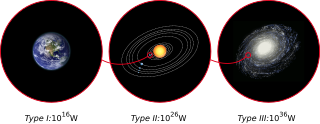Related Research Articles

A Dyson sphere is a hypothetical megastructure that completely encompasses a star and captures a large percentage of its solar power output. The concept is a thought experiment that attempts to explain how a spacefaring civilization would meet its energy requirements once those requirements exceed what can be generated from the home planet's resources alone. Because only a tiny fraction of a star's energy emissions reaches the surface of any orbiting planet, building structures encircling a star would enable a civilization to harvest far more energy.

The Drake equation is a probabilistic argument used to estimate the number of active, communicative extraterrestrial civilizations in the Milky Way Galaxy.

The search for extraterrestrial intelligence (SETI) is a collective term for scientific searches for intelligent extraterrestrial life, for example, monitoring electromagnetic radiation for signs of transmissions from civilizations on other planets.

The Kardashev scale is a method of measuring a civilization's level of technological advancement based on the amount of energy it is able to use. The measure was proposed by Soviet astronomer Nikolai Kardashev in 1964.
Extraterrestrial intelligence refers to hypothetical intelligent extraterrestrial life. The question of whether other inhabited worlds might exist has been debated since ancient times. The modern form of the concept emerged when the Copernican Revolution demonstrated that the Earth was a planet revolving around the Sun, and other planets were, conversely, other worlds. The question of whether other inhabited planets or moons exist was a natural consequence of this new understanding. It has become one of the most speculative questions in science and is a central theme of science fiction and popular culture.
Nikolai Semyonovich Kardashev was a Soviet and Russian astrophysicist, Doctor of Physical and Mathematical Sciences, and the deputy director of the Astro Space Center of PN Lebedev Physical Institute of the Russian Academy of Sciences in Moscow.
A continuous wave or continuous waveform (CW) is an electromagnetic wave of constant amplitude and frequency, typically a sine wave, that for mathematical analysis is considered to be of infinite duration. Continuous wave is also the name given to an early method of radio transmission, in which a sinusoidal carrier wave is switched on and off. Information is carried in the varying duration of the on and off periods of the signal, for example by Morse code in early radio. In early wireless telegraphy radio transmission, CW waves were also known as "undamped waves", to distinguish this method from damped wave signals produced by earlier spark gap type transmitters.
The idea of self-replicating spacecraft has been applied—in theory—to several distinct "tasks". The particular variant of this idea, applied to the idea of space exploration, is known as a von Neumann probe, after the mathematician John von Neumann, who originally conceived of it. Other variants include the Berserker and an automated terraforming seeder ship.
Xenoarchaeology, a branch of xenology dealing with extraterrestrial cultures, is a hypothetical form of archaeology that exists mainly in works of science fiction. The field is concerned with the study of the material remains to reconstruct and interpret past life-ways of alien civilizations. Xenoarchaeology is not currently practiced by mainstream archaeologists due to the current lack of any material for the discipline to study.
Megascale engineering is a form of exploratory engineering concerned with the construction of structures on an enormous scale. Typically these structures are at least 1,000 km (620 mi) in length—in other words, at least one megameter, hence the name. Such large-scale structures are termed megastructures.
The zoo hypothesis speculates on the assumed behavior and existence of technologically advanced extraterrestrial life and the reasons they refrain from contacting Earth. It is one of many theoretical explanations for the Fermi paradox. The hypothesis states that alien life intentionally avoids communication with Earth to allow for natural evolution and sociocultural development, and avoiding interplanetary contamination, similarly to people observing animals at a zoo. The hypothesis seeks to explain the apparent absence of extraterrestrial life despite its generally accepted plausibility and hence the reasonable expectation of its existence. A variant on the zoo hypothesis suggested by the former MIT Haystack Observatory scientist John Allen Ball, is the laboratory hypothesis, where humanity is being subjected to experiments, with Earth being a giant laboratory.
The Great Filter, in the context of the Fermi paradox, is one possible resolution of the paradox. It posits that in the development of life from the earliest stages of abiogenesis to reaching the highest levels of development on the Kardashev scale, there exists some particular barrier to development that makes detectable extraterrestrial life exceedingly rare.
White's law, named after Leslie White and published in 1943, states that, other factors remaining constant, "culture evolves as the amount of energy harnessed per capita per year is increased, or as the efficiency of the instrumental means of putting the energy to work is increased".
The air interface, or access mode, is the communication link between the two stations in mobile or wireless communication. The air interface involves both the physical and data link layers of the OSI model for a connection.

Stellar engines are a class of hypothetical megastructures used to control the motion of a star system. The concept has been introduced by Badescu and Cathcart. Some variants use this energy to produce thrust, and thus accelerate a star and anything orbiting it in a given direction. The creation of such a system would make its builders a type-II civilization on the Kardashev scale.
Active SETI is the attempt to send messages to intelligent extraterrestrial life. Active SETI messages are usually sent in the form of radio signals. Physical messages like that of the Pioneer plaque may also be considered an active SETI message. Active SETI is also known as METI. The term METI was coined by Russian scientist Alexander Zaitsev, who denoted the clear-cut distinction between Active SETI and METI:
The science known as SETI deals with searching for messages from aliens. METI deals with the creation and transmission of messages to aliens. Thus, SETI and METI proponents have quite different perspectives. SETI scientists are in a position to address only the local question “does Active SETI make sense?” In other words, would it be reasonable, for SETI success, to transmit with the object of attracting ETI’s attention? In contrast to Active SETI, METI pursues not a local and lucrative impulse, but a more global and unselfish one – to overcome the Great Silence in the Universe, bringing to our extraterrestrial neighbors the long-expected annunciation “You are not alone!”

Radio is the technology of signaling and communicating using radio waves. Radio waves are electromagnetic waves of frequency between 30 hertz (Hz) and 300 gigahertz (GHz). They are generated by an electronic device called a transmitter connected to an antenna which radiates the waves, and received by another antenna connected to a radio receiver. Radio is very widely used in modern technology, in radio communication, radar, radio navigation, remote control, remote sensing, and other applications.
Engineering on an astronomical scale, or astronomical engineering, i.e., engineering involving operations with whole astronomical objects, is a known theme in science fiction, as well as a matter of recent scientific research and exploratory engineering.
The cultural impact of extraterrestrial contact is the corpus of changes to terrestrial science, technology, religion, politics, and ecosystems resulting from contact with an extraterrestrial civilization. This concept is closely related to the search for extraterrestrial intelligence (SETI), which attempts to locate intelligent life as opposed to analyzing the implications of contact with that life.

A planetary civilization or global civilization is a civilization of Type I on the Kardashev scale. This type of civilization is likely to be reliant on renewable energy sources such as stellar power, as well as powerful non-renewable sources such as nuclear fusion. A Type I civilization's energy consumption level is roughly equivalent to the solar insolation on Earth (between 1016 and 1017 watts) ─ around 3 orders of magnitude higher than that of contemporary humanity (around 2×1013 as of 2020).
References
- ↑ Vakoch, Douglas A. (2011-04-01). Communication with Extraterrestrial Intelligence (CETI). SUNY Press. ISBN 9781438437958.